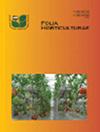Basal defoliation, salicylic acid and cyanocobalamin to ameliorate the physiological and biochemical characteristics of flood-irrigated ‘Crimson Seedless’ grapevines in a semi-arid Mediterranean climate
IF 1.8
4区 农林科学
Q2 HORTICULTURE
引用次数: 0
Abstract
ABSTRACT There is a high retail demand for ‘Crimson Seedless’ grape. Cluster shape, berry size, colour, and sugar contents influence the overall fruit quality and marketability. In many commercial vineyards of flood-irrigated clay soils under warm and humid semi-arid climates, adequate irrigation may lead to an enhanced fruit set that could potentially be associated with restricted berry growth, compact clusters, and poor berry colour and taste. To assess the role of some agronomic practices that may influence the canopy microclimate, and affect primary and secondary metabolites, seven treatments arranged in a randomised complete block design (RCBD) system with three replicates each (three vines per replicate) were applied as follow; the control (T1), 5-leaf basal defoliation at pre-bloom (BDPB) (T2), BDPB + foliar spray (FS) of 200 mg · L –1 salicylic acid (SA) (T3), BDPB + FS of 20 mg · L –1 cyanocobalamin (CCA) (T4), 5-leaf basal defoliation at full bloom (BDFB) (T5), BDFP + SA (T6) and BDFB + CCA (T7). Foliar applications were applied at 1) 2 weeks after the beginning of vegetative growth, 2) full bloom and 3) veraison stages. The analysis of variance (ANOVA), the principle component analysis (PCA) and the two-way hierarchical cluster analysis (HCA) indicated that BDPB (T2) generally has a better effect than that of BDFB (T5). The most pronounced effect on vegetative growth (shoot length and leaf area), photosynthesis activity (leaf chlorophyll and carbohydrate contents), fruit weight and dimensions, and total yield was observed in the case of T3, followed by T6, whereas concerning berry firmness, colour (anthocyanins) and sensory characteristics (soluble solids: acids ratio, total sugars and phenols), the most pronounced effect was observed in the case of T4, followed by T7.在半干旱的地中海气候条件下,基底落叶、水杨酸和氰钴胺改善洪水灌溉“深红色无籽”葡萄的生理生化特性
“深红无籽”葡萄的零售需求量很大。簇形、浆果大小、颜色和含糖量影响果实的整体品质和适销性。在温暖湿润的半干旱气候下,许多商业葡萄园采用洪水灌溉的粘土土壤,适当的灌溉可能会导致结实的果实,这可能与浆果生长受限、丛穗紧凑、浆果颜色和味道差有关。为了评估一些可能影响冠层小气候和影响初级和次级代谢物的农艺措施的作用,在随机完全区组设计(RCBD)系统中安排了7个处理,每个处理3个重复(每个重复3个藤蔓),如下:对照(T1)、开花前5叶基落叶(BDPB) (T2)、BDPB + 200 mg·L -1水杨酸(SA)叶面喷雾(FS) (T3)、BDPB + 20 mg·L -1氰钴胺(CCA)叶面喷雾(T4)、开花前5叶基落叶(BDFB) (T5)、BDFP + SA (T6)和BDFB + CCA (T7)。叶面施药时间分别为:营养生长开始后2周、花期开始后2周、花期结束后3周。方差分析(ANOVA)、主成分分析(PCA)和双向层次聚类分析(HCA)表明,BDPB (T2)总体效果优于BDFB (T5)。对营养生长(茎长和叶面积)、光合活性(叶片叶绿素和碳水化合物含量)、果实重量和尺寸以及总产量的影响最显著的是T3,其次是T6;而对浆果硬度、颜色(花青素)和感官特性(可溶性固形物:酸比、总糖和酚)的影响最显著的是T4,其次是T7。
本文章由计算机程序翻译,如有差异,请以英文原文为准。
求助全文
约1分钟内获得全文
求助全文
来源期刊

Folia Horticulturae
Agricultural and Biological Sciences-Horticulture
CiteScore
3.40
自引率
0.00%
发文量
13
审稿时长
16 weeks
期刊介绍:
Folia Horticulturae is an international, scientific journal published in English. It covers a broad research spectrum of aspects related to horticultural science that are of interest to a wide scientific community and have an impact on progress in both basic and applied research carried out with the use of horticultural crops and their products. The journal’s aim is to disseminate recent findings and serve as a forum for presenting views as well as for discussing important problems and prospects of modern horticulture, particularly in relation to sustainable production of high yield and quality of horticultural products, including their impact on human health.
 求助内容:
求助内容: 应助结果提醒方式:
应助结果提醒方式:


